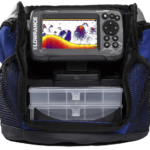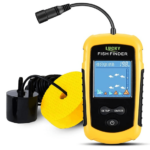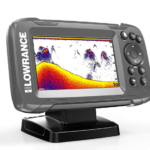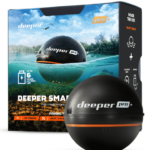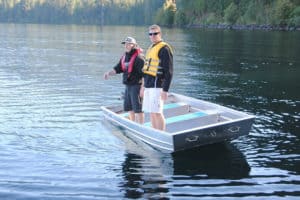Freshwater fishing is an enjoyable activity that requires the right equipment to make the most of it. One of the essential tools for any angler is a fish finder.
A fish finder is a device that uses sonar technology to locate fish underwater. It displays the location of fish, the depth of water, and the type of bottom surface. In this article, we will discuss the best fish finder for freshwater fishing.
When it comes to finding the best fish finder for freshwater fishing, there are several factors to consider. The first thing to consider is the type of fish finder.
There are two types of fish finders: portable and fixed. Portable fish finders are ideal for those who fish from different locations, while fixed fish finders are best for those who fish from a single location.
Another factor to consider is the display. The display should be easy to read in bright sunlight and at night. The size of the screen is also important. A larger screen will make it easier to see the details of what is under the water.
Finally, the transducer is an essential component of a fish finder. The transducer sends out the sonar signal and receives the echo. It is important to choose a transducer that is compatible with the fish finder and can accurately detect fish.
After researching and testing various fish finders, we have identified the best fish finder for freshwater fishing. This fish finder has a portable design, a clear and easy-to-read display, and a high-quality transducer.
With this fish finder, anglers can easily locate fish and make the most of their freshwater fishing experience.
Click here to see our #1 top pick for the best fish finder for freshwater fishing on Amazon
As an Amazon Associate, I earn from qualifying purchases
Best Fish Finders for Freshwater Fishing
We have researched and tested various fish finders to bring you the best options for freshwater fishing.
Our team of experts has evaluated each product based on its features, performance, and overall value. Whether you’re a beginner or an experienced angler, these fish finders will help you locate and catch more fish.
Here are our top picks for the best fish finders for freshwater fishing.
Garmin Striker Fish Finder
If you’re looking for the best fish finder for freshwater fishing, we highly recommend the Garmin Striker Fish Finder with ClearVu technology.
Pros
- ClearVu scanning Sonar provides detailed representations of objects, structure, and fish
- Keyed interface with dedicated buttons makes it easy to use and install
- Waypoint map allows you to easily view, mark, and navigate to locations such as brush piles, stumps, and docks
Cons
- Chirp Sonar may not provide the widest range of information
- Display size may be too small for some users
- May not be suitable for saltwater fishing beyond 750 feet
We were impressed with the ClearVu scanning Sonar, which provides near photographic images of what’s in the water around your boat. This feature is especially helpful when trying to spot fish in murky water.
The keyed interface with dedicated buttons also made it easy to use and install. We appreciated the waypoint map, which allowed us to mark our favorite fishing spots and easily navigate back to them.
One downside is that the Chirp Sonar may not provide the widest range of information, but we still found it to be effective in creating crisper fish arches with better target separation.
Additionally, the display size may be too small for some users, but we found it to be sufficient for our needs. Finally, while the Garmin Striker Fish Finder is suitable for saltwater fishing up to 750 feet, it may not be the best option for deeper saltwater fishing.
Overall, we believe the Garmin Striker Fish Finder is the best fish finder for freshwater fishing on the market. Its ClearVu scanning Sonar, keyed interface, and waypoint map make it a reliable and efficient tool for any angler.
LUCKY Portable Fish Finder Handheld Kayak Fish Finders
If you want to have a reliable and portable fish finder for freshwater fishing, then the LUCKY Portable Fish Finder Handheld Kayak Fish Finders is a great choice.
Pros
- The updated 2.4inch TFT color LCD screen is clear and can display underwater contour, water depth, water temperature, and fish size and depth.
- The fish finder portable provides you with 26FT wired operating distance and 328FT depth detection, making it useful for various fishing methods.
- The fish depth finder is rechargeable and can work continuously for about 5 hours with a full charge.
Cons
- The handheld display can be affected by water and cold weather.
- The accuracy of the unit is questionable, as it tends to mark a lot of fish on the bottom, which could be boulders or other objects.
- The product does not come with a carrying case.
We have used the LUCKY Portable Fish Finder Handheld Kayak Fish Finders Wired Fish Depth Finder Sonar Sensor Transducer for Boat Fishing Sea Fishing, and we were impressed by its features.
The device has two user modes: TRANSDUCER/SIMULATION, which allows you to try all functions in simulation mode and go fishing in transducer mode.
The fish finder portable is also easy to use, and you can read the data either at night or in the sunlight easily because the brightness of the display can be adjusted.
Additionally, you can set up sensitivity, screen brightness, depth range, zoom, depth alarm, fish alarm, fish icon, units(FT/M ℃/℉)alter, and language by yourself.
The bracket allows you to attach the sensor transducer to your boat or kayak, making it useful for different fishing methods such as ice fishing, river fishing, sea fishing, shore fishing, kayak fishing, etc.
Overall, the LUCKY Portable Fish Finder Handheld Kayak Fish Finders Wired Fish Depth Finder Sonar Sensor Transducer for Boat Fishing Sea Fishing is a great product for those who want a reliable and portable fish finder for freshwater fishing.
Lowrance HOOK2 Fish Finder Fish Finder GPS Only / No Mapping
If you want a reliable and easy-to-use fish finder for freshwater fishing, the Lowrance HOOK2 4x Fish Finder is a good choice.
Pros
- The auto-tuning sonar and phone-like menus make it very easy to use.
- The wide-angle CHIRP sonar cone gives you double the coverage of traditional fish finders.
- The single transducer can be mounted in various ways, making it ideal for small boats and kayaks.
Cons
- The GPS plotter is basic and may not be sufficient for more advanced navigation.
- The 4.3-inch screen may be too small for some users.
- The included Bullet Skimmer transducer only provides traditional 2-D CHIRP sonar views.
We recently tested the Lowrance HOOK2 4x Fish Finder and were impressed with its ease of use and wide-angle sonar coverage. The auto-tuning sonar and phone-like menus make it very easy to operate, even for beginners.
The wide-angle CHIRP sonar cone is a standout feature, giving you double the coverage of traditional fish finders and making it easier to locate fish. The single transducer can be mounted in various ways, making it ideal for small boats and kayaks with limited console space.
However, the GPS plotter is basic and may not be sufficient for more advanced navigation. The 4.3-inch screen may also be too small for some users, especially those who prefer larger displays.
Additionally, the included Bullet Skimmer transducer only provides traditional 2-D CHIRP sonar views, which may not be enough for some anglers.
In summary, the Lowrance HOOK2 4x Fish Finder is a great option for those who want a reliable and easy-to-use fish finder for freshwater fishing.
Its wide-angle sonar coverage and various mounting options make it a versatile choice, although the GPS plotter and small screen may be drawbacks for some users.
LUCKY Kayak Portable Fish Depth Finder
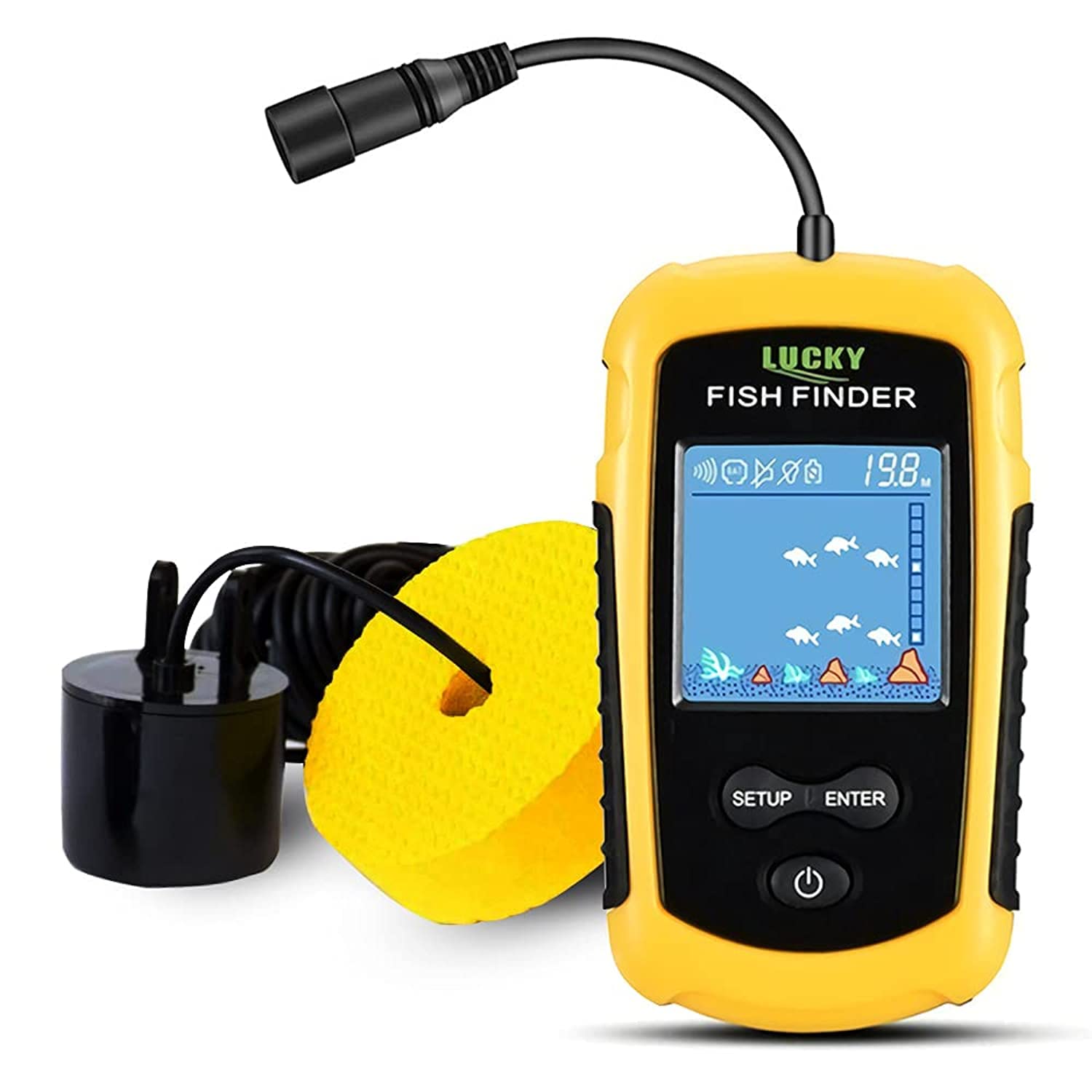
If you’re looking for an affordable and portable fish finder for freshwater fishing, the LUCKY Kayak Portable Fish Depth Finder is a great option.
Pros
- The LUCKY fish finder is portable and easy to use with one hand.
- The handheld device displays helpful data such as fish depth, water depth, and weeds, sand, and rocks on the bottom.
- The fish finder is ideal for fishing in both freshwater and saltwater.
Cons
- The battery life of the fish finder is only 4-5 hours, which may not be sufficient for long fishing trips.
- The accuracy of the fish finder may be affected by water turbidity.
- The device may produce false alarms if it is placed in demo mode.
We recently tested the LUCKY fish finder and were impressed with its performance. The device is easy to use and displays accurate data on fish depth and water depth. We also appreciated the 5 levels of sensitivity adjustment, which allowed us to use the fish finder in both clear and turbid water.
The neck strap that comes with the device is a nice touch, as it allows you to wear the fish finder around your neck when you’re busy on the kayak or boat.
One of the standout features of the LUCKY fish finder is its ability to display short and tall weeds, sand, and rocks on the bottom.
This information can be very helpful when trying to find the best fishing spot. The fish and fish schools alarm is also a nice feature, as it alerts you when fish or fishing schools are passing by.
Overall, we think the LUCKY Kayak Portable Fish Depth Finder is a great option for those looking for an affordable and portable fish finder for freshwater fishing.
While the battery life and accuracy may not be perfect, the device provides accurate and helpful data that can improve your fishing experience.
Reelsonar Portable Fish Finder

If you’re looking for a portable and wireless fish finder that can sync with your smartphone or tablet, then the iBobber from Reelsonar could be the perfect choice for you.
Pros
- Easy to use and portable
- Accurate readings of bottom contours, depths, structures, and fish
- Works in both saltwater and freshwater
Cons
- Limited range of 100 feet
- The app can be buggy at times
- The battery life could be longer
We’ve been using the iBobber for a while now, and we’re impressed with its performance.
The sonar technology provides accurate readings of bottom contours, depths, structures, and fish, and the free app syncs via Bluetooth Smart to the iBobber device, allowing you to map waterbeds, mark spots, log water temps and depth, add lures, species, and photos in the trip log.
The LED beacon, and strike and fish alarms, are great for ice fishing, carp, and night fishing.
The patented fish finder displays fish by size and depth to get you on the lunkers fast. Great for finding smallmouth and largemouth bass, panfish (like crappie and perch), salmon, trout, walleye, pike, muskie and other game fish and edible species within 135’ depth.
It’s also ideal for kayak or canoe fishing and for bottom-sounding areas not available by boat.
Overall, the iBobber is a great personal fish finder on the market for fishing from shore and docks. It’s perfect for fishing trips, in your RV, on your boat for those tight spots, in your car with your collapsible rod or in your tackle box along with your other critical fishing gear.
It’s even a great asset to conservationists looking to log water temp, depth and bottom structures in multiple locations over time.
If you’re looking for a portable fish finder that’s easy to use and accurate, then the iBobber from Reelsonar is definitely worth checking out.
Buying Guide
When choosing the best fish finder for freshwater fishing, there are several factors to consider. Here are some things to keep in mind when making your decision:
Transducer Type
As per Fish Finders (.info), the transducer is the part of the fish finder that sends out and receives sonar signals. There are two main types of transducers: single frequency and dual frequency.
Single-frequency transducers are best for shallow water and smaller fish, while dual-frequency transducers are better for deeper water and larger fish. Consider the depth of the water you’ll be fishing in and the size of the fish you’re targeting when choosing a transducer type.
Display
The display is where you’ll see the information from the fish finder. Look for a display that is large enough to see clearly, even in bright sunlight. Color displays are also helpful, as they can make it easier to distinguish between different types of fish and underwater structures.
GPS
Many fish finders come with GPS capabilities, which can be helpful for marking fishing spots and navigating unfamiliar waters. Look for a fish finder with accurate GPS and mapping features if this is important to you.
Power
The power of a fish finder is measured in watts. The higher the wattage, the stronger the sonar signal and the deeper the fish finder can penetrate the water. Consider the depth of the water you’ll be fishing in when choosing a fish finder with the appropriate wattage.
Other Features
There are several other features to consider when choosing a fish finder, including:
- Cone angle: The cone angle determines the width of the sonar beam. A wider cone angle can cover more area, but may not be as accurate.
- Frequency: The frequency of the sonar signal determines the level of detail you can see. Higher frequencies provide more detail, but may not penetrate as deeply.
- CHIRP: CHIRP technology sends out a range of frequencies, providing more detailed and accurate information about the underwater environment.
- Side imaging: Side imaging can provide a wider view of the underwater environment, making it easier to spot fish and structures.
Consider which of these features are most important to you when choosing a fish finder for freshwater fishing.





